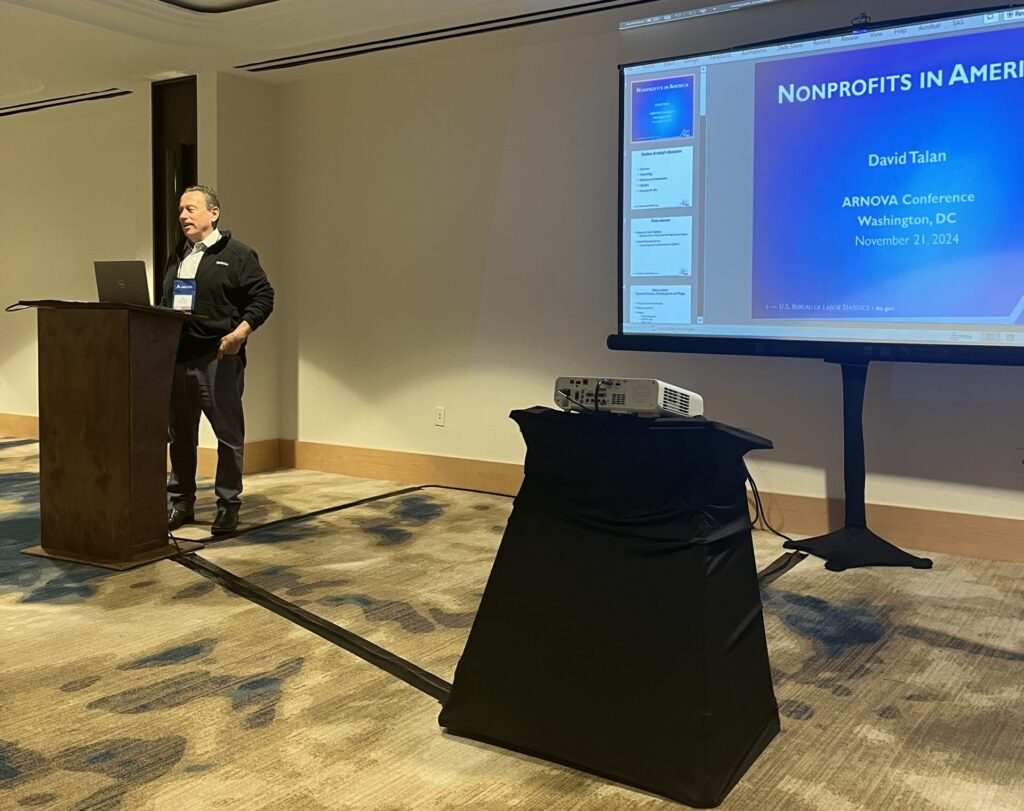Center leader, Dr. Alan Abramson, brought together federal staff from several federal agencies to show nonprofit researchers how to access federal data regarding nonprofit employment, federal funding of nonprofits, volunteering, and more at the Association for Research on Nonprofit Organizations and Voluntary Action’s (ARNOVA) 2024 annual conference in Washington, DC on November 21.

Julie Beckhusen from the Census Bureau kicked off the panel by discussing the American Community Survey, a nationwide, continuous survey mailed to 3.5 million addresses. In the employment section of the survey, the class of worker variable categorizes workers by the type of organization they are employed by: for-profit, nonprofit, government, or self-employed. As a result, researchers can find data on the occupation, industry, means of transit, median earning, and sex of nonprofit employees. This data is available at data.census.gov. Users can also use the Census Bureau’s Microdata Access Tool (MDAT) to create custom tables with these data.
Next, Dr. Mary Hyde from AmeriCorps discussed the Volunteering and Civic Life Supplement to the Census Bureau’s Current Population Survey (CPS). This supplemental survey has been conducted every other year alongside the September version of the CPS since 2002. It provides data on formal and informal volunteering as well as political engagement across the country. Data from the 2023 Volunteering and Civic Life Supplement is now available on the Census Bureau’s website.
Grace Lim from the Treasury Department’s Bureau of Fiscal Service followed by telling attendees how they can access data regarding federal funding of nonprofits via USASpending.gov. USASpending.gov was established through the Digital Accountability and Transparency Act of 2014 and documents government awards to state and local governments, corporations, and nonprofits. Nonprofit data is sometimes available at the subaward level for federal programs that pass funding through state or local governments to nonprofits. Unfortunately, the subaward level data that shows funding going to nonprofits and other subawardees is incomplete for some programs, making it difficult to get a full picture of federal funds flowing to nonprofits.
Next, David Talan from the Bureau of Labor Statistics (BLS) explained how the agency merges data from its Quarterly Census of Employment and Wages (QCEW) and the Internal Revenue Service’s Exempt Organization Business Master File (EO BMF) to produce employment and wage data on nonprofit organizations. QCEW contains data on business establishments’ monthly employment, quarterly wages, industry, and employer identification number (EIN). The EO BMF is a list of exempt organizations’ names, industries, incomes, and EINs, but it does not include any employment and wage data. Using the two files, BLS is able to produce employment and wage data on 501(c)(3) nonprofit organizations. BLS currently releases this nonprofit data every five years, and the agency released data covering 2018-2022 earlier this year. You can find this data on the BLS’s Business Employment Dynamics webpage.

(Note: Mason’s Nonprofit Center has developed a report based on BLS’s nonprofit employment data for 2018-2022 that analyzes the impact of the COVID-19 pandemic on the nonprofit workforce. The Center will also soon make available Nonprofit Works, an online portal that will allow users to pull down employment and wage data of interest. For more information on the Center’s Nonprofit Employment Data (NED) project, please see the NED portion of our website).
Takashi Yamashita from the Bureau of Economic Analysis (BEA) concluded the ARNOVA panel by discussing how the agency publishes GDP data on the nonprofit sector. In BEA data, nonprofits are referred to as “nonprofit institutions serving households” (NPISH). Since nonprofit organizations do not sell many goods and services at market value, the BEA uses the cost of production to estimate the output of NPISH. Yamashita also provided some analysis of BEA’s NPISH data. According to Yamashita, NPISH has had a negative net saving since 2007. However, the NPISH balance sheet appears healthy, and NPISH net worth has increased over time. You can find NPISH data in the National Income and Product Account (NIPA) tables on BEA’s website.
By bringing together these panelists at the ARNOVA conference, the Nonprofit Center hoped to familiarize nonprofit researchers with the abundance of nonprofit data collected by federal agencies, and to make federal data staff more aware of other federal staff working with nonprofit data. The Center will seek to advance both of these goals in its future work.
